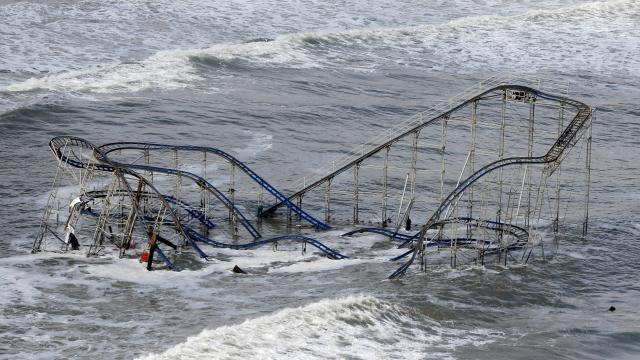The first time climate change hit home for me, I was at the top of a ski run. I don’t recall the exact date or even the exact mountain I was on (hell, maybe it was a dream), but I remember looking down the slope of untracked powder and wondering how long it would be there. It stuck with me, and my life swerved from park ranger-ski bum-waiter to, well, this.
Early on in journalist David Wallace Wells’ highly-anticipated new book on climate change, The Uninhabitable Earth, he talks about his transformation into a Climate Person. After noting “I am not an environmentalist, and don’t even think of myself as a nature person,” he points to a file he keeps:
“A few years ago, I began collecting stories of climate change, many of them terrifying, gripping, uncanny narratives, with even the most small-scale stories playing like fables: A group of Arctic scientists trapped when melting ice isolated their research center, on an island populated also by a group of polar bears; a Russian boy killed by anthrax released from a thawing reindeer carcass, which had been trapped in permafrost for many decades.”
Wallace-Wells and I took slightly different routes to the same endpoint, but it’s clear there are human values that shifted our respective focuses. Which is what makes Wallace-Wells’ new book such a strange work. It’s a gut punch of facts and figures, a terrifying science report written by a journalist that also functions as a polemic against the neoliberal world order.
The book wants you to freak out, and while it shines a light on the appalling future unchecked carbon pollution could create, it’s largely devoid of characters that can make an intractable problem feel grounded. If you, like me, feel an agitated energy after finishing it, you might also be left wondering how to focus that energy.
If the title of the book sounds familiar, it’s because of Wallace-Wells’ eponymous 2017 New York Magazine article that roared into the climate world like a Category 6 hurricane. Based on the worst case climate scenarios, the article laid out in devastating detail just how fucked humanity is if we let carbon pollution continue to pile up in the atmosphere.
It was also pilloried by some climate scientists and communication experts as too alarmist, but the Google Analytics told a somewhat different story as it became the magazine’s most read story of all-time until it was displaced by an excerpt of Michael Wolff’s equally sensational Fire and Fury.
And the story definitely got people talking about climate change, which is exceedingly hard to do.
Wallace Wells’ new book builds off that piece. It shows that we’re still fucked, but the relative succinctness of the article has been stretched to 300 pages, using the scientific literature to chronicle the level of fuckedness in excruciating detail—floods, plagues, fires, and a laundry list of other biblical maladies. “If you have made it this far, you are a brave reader,” he writes at the halfway point.
Indeed, the litany of terrors is enough to beat you down, both emotionally and intellectually. Especially seeing as the book offers relatively little guidance on what the likelihood of malady X will occur is, or a time frame for when malady Y could hit, or how warm the planet would have to get for malady Z.
But the piece that could have really brought climate terror home for me—the stories of human suffering and resilience, from Syria to Panama Beach to Paradise—is largely absent. From The Uninhabitable Earth’s God’s-eye view, the huddled masses are just that. A souped up hurricane over here, a few hundred million climate migrants there, a monster heat wave just around the corner.
The approach feels a few months out of step in light of the personal, grounded discourse around the Green New Deal and the passion shown by groups like the Sunrise Movement and youth climate strikers. None appear in the book (in fact he writes “we have no New Deal revival waiting around the corner”), speaking to how fast discussions about climate policy are now moving.
Unlike some, I wholly agree with Wallace Wells’ sentiment that it’s time to panic and that fear could be the instinct that saves humanity from its worst impulses. I also have no issue with presenting how terrible things could get, and despite the gatekeeping that sprung up in response to his original article, there’s a lot we don’t know about climate change communication. The Uninhabitable Earth could well tip the scales for some people to finally give a damn about climate change.
But human context for that panic can help direct the actions people take. So can offering guidance on what people can do, and yet such guidance is in short supply. Wallace-Wells rightfully blasts the capitalist system that has tied growth and fossil fuels together. But the proposed solutions feel relatively distant in his analysis, and most are about systemic changes rather than personal ones.
While I’m not naive enough to think that, say, eating a 2050 diet now is going to change the course of human history in the same way meaningful climate policy could, it seems self-defeating to dismiss personal choice or focus solely on the global “we.” In his final chapter, Wallace Wells points to carbon taxes, plummeting renewables prices, and changing the global diet as the solutions available, but the instruction manual for how to activate them is obscured.
For those steeped in climate literature and on the alarmed end of the spectrum already, The Uninhabitable Earth is a clarion call to redouble their efforts, call their members of Congress, and join a local climate strike. But without context of how likely shit is to hit the fan, human narratives to ground the collective suffering, or what people can do to stop it all, I worry the nightmares of Wallace-Wells’ tome could be lost in the increasing stormy sea of white noise.
